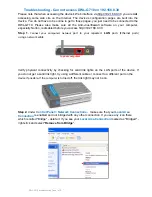
IDT SMBus Interfaces
PES12T3G2 User Manual
5 - 6
January 28, 2013
Notes
To write a byte to the serial EEPROM, the root should configure the ADDR field with the byte address of
the serial EEPROM location to be written and set the OP field to “write.” If the serial EEPROM is not busy
(i.e., the BUSY bit is cleared), the write operation may be initiated by writing the value to be written to the
DATA field. When the write operation completes, the DONE bit is set and the busy bit is cleared. Initiating a
serial EEPROM read or write operation when the BUSY bit is set produces undefined results.
SMBus errors may occur when accessing the serial EEPROM. If an error occurs, it is reported in the
SMBus Status (SMBUSSTS) register. Software should check for errors before and after each serial
EEPROM access.
I/O Expanders
The PES12T3G2 utilizes external SMBus/I
2
C-bus I/O expanders connected to the master SMBus inter-
face for hot-plug and port status signals. The PES12T3G2 is designed to work with Phillips PCA9555
compatible I/O expanders (i.e., PCA9555, PCA9535, and PCA9539). See the Phillips PCA9555 data sheet
for details on the operation of this device.
An external SMBus I/O expander provides 16 bit I/O pins that may be configured as inputs or outputs.
The PES12T3G2 supports up to three external I/O expanders numbered 0, 2, and 4. Table 5.4 summa-
rizes the allocation of functions to I/O expanders. I/O expanders zero and two are used to provide hot-plug
I/O signals while I/O expander four is used to provide link status and activity LED control.
I/O expander signals associated with LED control (i.e., link status and activity) are active low (i.e., driven
low when an LED should be turned on).
I/O expander signals associated with hot-plug signals are not inverted.
During the PES12T3G2 initialization the SMBus/I
2
C-bus address allocated to each I/O expander used in
that system configuration should be written to the corresponding IO Expander Address (IOE[0,2,4]ADDR)
field. The IOE[0,2]ADDR fields are contained in the I/O Expander Address 0 (IOEXPADDR0) register while
the IOE[4]ADDR fields is contained in the SMBus I/O Expander Address 1 (IOEXPADDR1) register.
Hot-plug outputs and I/O expanders may be initialized via serial EEPROM. Since the I/O expanders and
serial EEPROM both utilize the master SMBus, no I/O expander transactions are initiated until serial
EEPROM initialization completes.
–
Since no I/O expander transactions are initiated until serial EEPROM initialization completes, it is
not possible to toggle a hot-plug output through serial EEPROM initialization (i.e., it is not possible
to cause a 0 -> 1 -> 0 transition or a 1 -> 0 -> 1 transition).
Whenever the value of an IOEXPADDR field is written, SMBus write transactions are issued to the
corresponding I/O expander by the PES12T3G2 to configure the device. This configuration initializes the
direction of each I/O expander signal and sets outputs to their default value.
SMBus I/O
Expander
Section
Function
0
Lower
Port 2 hot-plug
Upper
Port 4 hot-plug
2
Lower
Upper
Power good inputs
4
Lower
Link status
Upper
Link activity
Table 5.4 I/O Expander Function Allocation
Содержание 89HPES12T3G2
Страница 10: ...IDT Table of Contents PES12T3G2 User Manual iv January 28 2013 Notes...
Страница 12: ...IDT List of Tables PES12T3G2 User Manual vi January 28 2013 Notes...
Страница 14: ...IDT List of Figures PES12T3G2 User Manual viii January 28 2013 Notes...
Страница 18: ...IDT Register List PES12T3G2 User Manual xii January 28 2013 Notes...
Страница 46: ...IDT Link Operation PES12T3G2 User Manual 3 10 January 28 2013 Notes...
Страница 66: ...IDT SMBus Interfaces PES12T3G2 User Manual 5 18 January 28 2013 Notes...
Страница 70: ...IDT Power Management PES12T3G2 User Manual 6 4 January 28 2013 Notes...
Страница 138: ...IDT Configuration Registers PES12T3G2 User Manual 8 62 January 28 2013 Notes...
















































